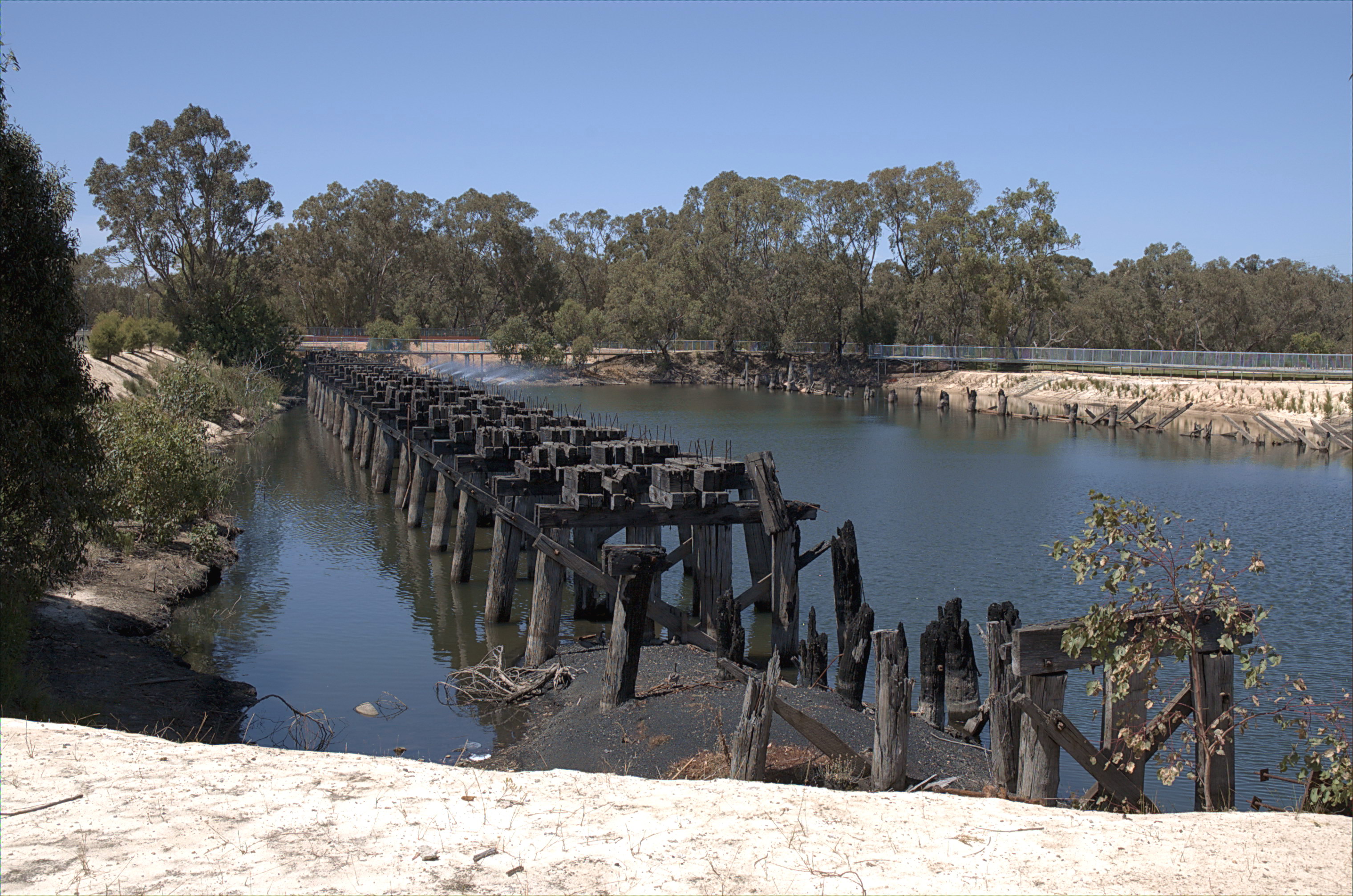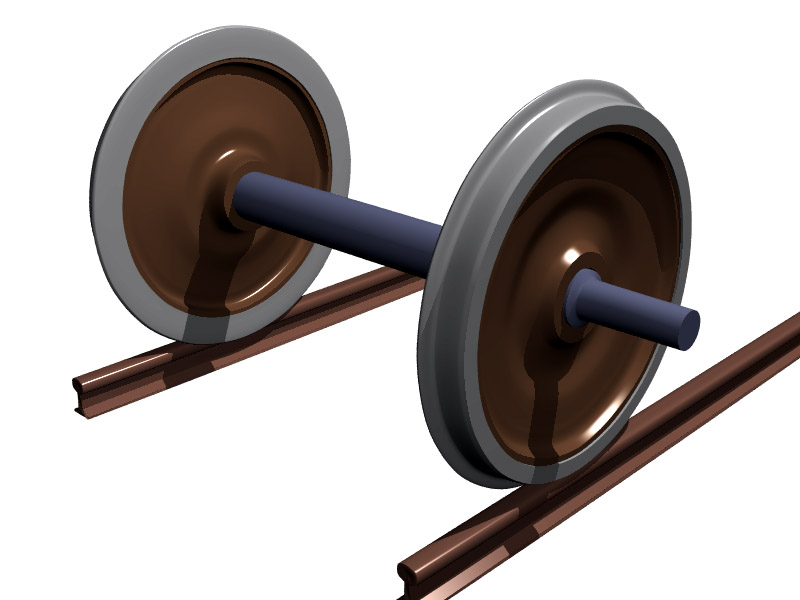|
WAGR AI Class
The WAGR AI class was a petrol-driven railmotor or railcar operated between 1935 and 1949 by the Western Australian Government Railways (WAGR). Officially designated as a petrol coach, it was built at the Midland Railway Workshops in 1935. Chassis and powertrain The railcar was based on a Dodge#Dodge trucks, Dodge K 32 truck chassis purchased from Winterbottom Motor Co in Perth, Western Australia. It had a four-wheeled bogie at the front end, and a Axle#Drive axle, drive axle at the rear. Powered by a 25 hp 6-cylinder in-line petrol engine, it was equipped with a four speed bidirectional gearbox, and could reach speeds of up to in each direction. Its fuel capacity was . Payload The railcar's maximum payload was eight passengers and of freight. Service history The WAGR built the railcar specifically to provide a service on the very lightly trafficked Marble Bar Railway, Port Hedland–Marble Bar railway in the Pilbara. Upon completion, it was shipped to Port Hedland aboa ... [...More Info...] [...Related Items...] OR: [Wikipedia] [Google] [Baidu] |
Marble Bar Railway
The Port Hedland–Marble Bar railway was a railway in the Pilbara region of Western Australia, running into the hinterland from the north-west coast. History The line was a Western Australian Government Railways (WAGR) gauge branch line which was isolated from the rest of the WAGR system. Construction was commenced in 1909, undertaken by the firm of Henry Teesdale Smith, and the line was opened in July 1911. The line had been proposed for some years before the date of opening. The closest railhead of the main WAGR rail system was over to the south at Meekatharra so most rolling stock and materials were shipped in and out Port Hedland. Due to heavy losses on the line, the Western Australian government asked 1922 Royal Commission of Inquiry into the Railway Department to make a specific inquiry into the running of the Port Hedland railway. The commissioner found that "the railway cannot be run effectively so long as it is administered by the Railways Department" and re ... [...More Info...] [...Related Items...] OR: [Wikipedia] [Google] [Baidu] |
Western Australian Government Railways
Western Australian Government Railways (WAGR) was the operator of railway services in the state of Western Australia between October 1890 and June 2003. Owned by the state government, it was renamed a number of times to reflect extra responsibility for tram and ferry operations that it assumed and later relinquished. Westrail was the trading name of WAGR from September 1975 until December 2000, when the WAGR's freight division and the Westrail name and logo were privatised. Its freight operations were privatised in December 2000 with the remaining passenger operations transferred to the Public Transport Authority in July 2003. History of operations The WAGR had its origins in 1879, when the Department of Works & Railways was established. The first WAGR line opened on 26 July 1879 between Geraldton and Northampton. It was followed by the Eastern Railway from Fremantle to Guildford via Perth on 1 March 1881. The WAGR adopted the narrow gauge of to reduce construction c ... [...More Info...] [...Related Items...] OR: [Wikipedia] [Google] [Baidu] |
Railmotor
Railmotor is a term used in the United Kingdom and elsewhere for a railway lightweight railcar, usually consisting of a railway carriage with a steam traction unit, or a diesel or petrol engine, integrated into it. Steam railcars Overview In the earliest days of railways, designers wished to produce a vehicle for passenger carrying that was economical to build and operate on routes where passenger numbers were light. A single coach with its own prime mover was a solution adopted in some cases; this may be thought of as the predecessor to the railcar, a term more associated with the use of internal combustion engines. William Bridges Adams started building railmotors in small numbers as early as 1848. The Bristol and Exeter Railway used a steam carriage. In most cases the early designs were unsuccessful technically, but in the early years of the twentieth century, street-running passenger tramways started to use small steam engines to draw tramcars, replacing the customary hor ... [...More Info...] [...Related Items...] OR: [Wikipedia] [Google] [Baidu] |
Railcar
A railcar (not to be confused with a railway car) is a self-propelled railway vehicle designed to transport passengers. The term "railcar" is usually used in reference to a train consisting of a single coach (carriage, car), with a driver's cab at one or both ends. Some railway companies, such as the Great Western, termed such vehicles " railmotors" (or "rail motors"). Self-propelled passenger vehicles also capable of hauling a train are, in technical rail usage, more usually called " rail motor coaches" or "motor cars" (not to be confused with the motor cars, otherwise known as automobiles, that operate on roads). The term is sometimes also used as an alternative name for the small types of multiple unit which consist of more than one coach. That is the general usage nowadays in Ireland when referring to any diesel multiple unit (DMU), or in some cases electric multiple unit (EMU). In North America the term "railcar" has a much broader sense and can be used (as an ab ... [...More Info...] [...Related Items...] OR: [Wikipedia] [Google] [Baidu] |
Midland Railway Workshops
The Midland Railway Workshops in Midland, Western Australia, were the main workshops for the Western Australian Government Railways (WAGR) for over 80 years. History The first railway workshops in Western Australia were located at Fremantle and shifted to Midland in 1904. The Midland Railway Workshops were involved with all WAGR rolling stock and engine construction and maintenance. Steam engines continued to operate on mainline service until 1971, and all major maintenance occurred at the workshops. Workforce Generations of workers at the workshops had considerable numbers of European migrants who arrived in Australia with limited English language, and there were significant groups of Italian migrants in the workforce. The workforce of the workshops had a rich history and, since closing, there have been projects to record oral history and collect information about the place and people involved. Closure In April 1993, the Richard Court Liberal State Government announced tha ... [...More Info...] [...Related Items...] OR: [Wikipedia] [Google] [Baidu] |
Dodge
Dodge is an American brand of automobiles and a division of Stellantis, based in Auburn Hills, Michigan. Dodge vehicles have historically included performance cars, and for much of its existence Dodge was Chrysler's mid-priced brand above Plymouth. Founded as the Dodge Brothers Company machine shop by brothers Horace Elgin Dodge and John Francis Dodge in the early 1900s, Dodge was originally a supplier of parts and assemblies to Detroit-based automakers like Ford. They began building complete automobiles under the "Dodge Brothers" brand in 1914, predating the founding of Chrysler Corporation. The factory located in Hamtramck, Michigan was the Dodge main factory from 1910 until it closed in January 1980. John Dodge died from the Spanish flu in January 1920, having lungs weakened by tuberculosis 20 years earlier. Horace died in December of the same year, perhaps weakened by the Spanish flu, though the cause of death was cirrhosis of the liver. Their company was sold by th ... [...More Info...] [...Related Items...] OR: [Wikipedia] [Google] [Baidu] |
Axle
An axle or axletree is a central shaft for a rotating wheel or gear. On wheeled vehicles, the axle may be fixed to the wheels, rotating with them, or fixed to the vehicle, with the wheels rotating around the axle. In the former case, bearings or bushings are provided at the mounting points where the axle is supported. In the latter case, a bearing or bushing sits inside a central hole in the wheel to allow the wheel or gear to rotate around the axle. Sometimes, especially on bicycles, the latter type axle is referred to as a '' spindle''. Terminology On cars and trucks, several senses of the word ''axle'' occur in casual usage, referring to the shaft itself, its housing, or simply any transverse pair of wheels. Strictly speaking, a shaft which rotates with the wheel, being either bolted or splined in fixed relation to it, is called an ''axle'' or ''axle shaft''. However, in looser usage, an entire assembly including the surrounding axle housing (typically a casting) i ... [...More Info...] [...Related Items...] OR: [Wikipedia] [Google] [Baidu] |
Koolinda
MV ''Koolinda'' was an Australian general cargo and passenger ship which operated as a coastal steamer off Western Australia from 1930 to 1959. General description ''Koolinda'' was built in 1926 by Harland and Wolff of Glasgow, Scotland for the State Shipping Service of Western Australia, State Shipping Service, and was registered at Fremantle, Western Australia, Fremantle. Her official tonnage was , she was 344 feet long, with a beam of 50 feet, and had diesel engines driving two propellers. ''Koolinda'' was used mostly for passenger and general freight transport on coastal routes in Western Australian waters. In May 1932, ''Koolinda'' famously narrowly missed seeing 1932 Kimberley rescue, two German aviators lost on the Kimberley (Western Australia), Kimberley coastline. The men were eventually found close to death. In the aftermath of the Sinking of HMAS Sydney, battle between HMAS ''Sydney'' and German auxiliary cruiser ''Kormoran'' in November 1941, the ''Koolinda'' rec ... [...More Info...] [...Related Items...] OR: [Wikipedia] [Google] [Baidu] |

.jpg)
.jpg)



